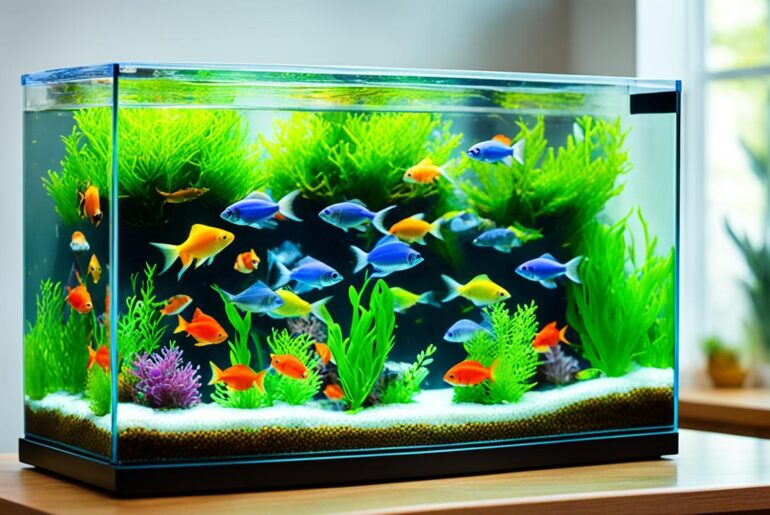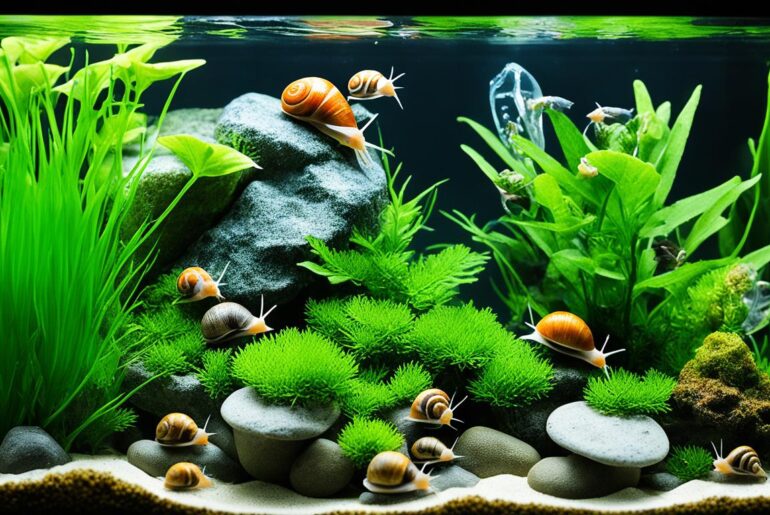As an avid aquarium enthusiast, I know firsthand the heartbreak of experiencing a freshwater tank emergency. It’s a sinking feeling, watching your beloved fish and aquatic plants struggle, knowing that their lives hang in the balance. The urgency to act is overwhelming, and you find yourself desperately searching for solutions to save their lives.
Whether it’s a sudden temperature fluctuation, a power outage, a leak, or a disease outbreak, emergencies can strike at any time. But fear not, fellow aquarists, for I have compiled a comprehensive guide to help you troubleshoot and resolve these freshwater tank issues with ease and confidence.
When it comes to the well-being of our aquatic companions, every second counts. By following the ten essential steps outlined in this article, you can swiftly address urgent aquarium repairs, solve fish tank problems, and provide the necessary emergency assistance that can make all the difference.
Key Takeaways:
- Be prepared to handle common freshwater tank emergencies
- Monitor water temperature and have backup heaters
- Maintain proper water flow with backup pumps
- Address power loss with generators or battery backup systems
- Deal with leaks or floods using essential supplies
Monitor Water Temperature
Fluctuating water temperature is one of the main culprits behind tank emergencies. To ensure the well-being of your aquarium inhabitants, it is crucial to monitor the water temperature at all times. You can do this by using a reliable thermometer or an advanced aquarium controller.
Heater failure is a common issue that can lead to drastic temperature changes in the tank. To prevent disasters, always have a backup heater on hand. Furthermore, using two heaters in your aquarium is a smart strategy for maintaining a stable temperature. By having a redundant heating system, you minimize the risks associated with heater failure. Remember to replace the heaters annually to ensure their optimal performance and reliability.
Stable water temperature is vital for the health and well-being of your fish and other aquatic species. Sudden fluctuations in temperature can cause stress and even death. Therefore, monitoring and maintaining the right temperature range is crucial for the overall success of your freshwater tank.
| Benefits of Monitoring Water Temperature |
|---|
| Prevents stress and health problems in fish |
| Ensures optimal metabolic rates |
| Promotes successful breeding and reproduction |
| Prevents fluctuations that can harm sensitive species |
| Creates a stable and comfortable environment |
By keeping a close eye on the water temperature in your freshwater tank, you can protect your aquatic friends from the detrimental effects of temperature fluctuations. With the right monitoring tools and backup equipment, you can enjoy a stable and thriving ecosystem.
Ensure Proper Water Flow
One of the key factors in maintaining a healthy freshwater tank is ensuring proper water flow. Water flow is essential for oxygenation and filtration, and any disruption in the flow can lead to emergencies. The main component responsible for providing the necessary water movement is the aquarium pump.
In the event of a power loss, the aquarium pump may fail, resulting in a lack of water circulation. This can lead to oxygen deprivation for the fish and a buildup of waste and toxins in the tank. To prevent such emergencies, it is important to have a backup pump in place.
A backup pump serves as a fail-safe measure in case the primary pump stops working. By having a backup pump ready, you can quickly restore water flow and ensure the well-being of your aquatic inhabitants.
In addition to a backup pump, it is also advisable to have a battery-powered air pump. During a power outage, the air pump can help maintain water movement and oxygenation, providing a lifeline for the fish until power is restored.
Furthermore, it is recommended to invest in a battery backup system or a generator to keep the water flowing even during extended power outages. These devices can provide a continuous power supply to the aquarium pump, ensuring that water circulation is maintained and emergencies are avoided.
To summarize, maintaining proper water flow is crucial for the health and well-being of your freshwater tank. By having a backup pump, a battery-powered air pump, and a battery backup system or generator, you can prevent emergencies caused by power loss and ensure a continuous flow of water.
| Benefits of Proper Water Flow | Consideration |
|---|---|
| Ensures oxygenation of the water | Use an aquarium pump and a backup pump to maintain water movement during power outages. |
| Prevents the buildup of waste and toxins | Invest in a battery-powered air pump to maintain water flow and oxygenation during power loss. |
| Creates a healthy environment for fish and other aquatic inhabitants | Use a battery backup system or a generator to keep water circulation uninterrupted during extended power outages. |
I hope you found this information helpful in understanding the importance of ensuring proper water flow in your freshwater tank. In the next section, we will discuss how to address power loss and keep your tank running smoothly.

Address Power Loss
Loss of power can be a major concern for freshwater tanks, as it can disrupt the delicate balance of the tank’s ecosystem and put the lives of your fish at risk. To ensure the continuous operation of your tank, it’s essential to have a reliable power backup system in place.
One of the most effective solutions for addressing power loss is to have a generator. A generator can provide a steady power supply to keep your tank equipment and life support systems running smoothly. When choosing a generator, make sure to select one that meets the power needs of your tank and consider factors such as wattage capacity and fuel efficiency.
Another option for mitigating power loss is a battery backup system. This system is designed to provide temporary power during outages, allowing your tank to continue functioning until the main power source is restored. It’s crucial to regularly test the battery backup system to ensure it is in proper working condition when you need it most.
Here’s a comparison of the benefits of a generator and a battery backup system:
| Generator | Battery Backup System |
|---|---|
| – Provides continuous power during outages | – Offers temporary power until main power is restored |
| – Wide range of models and capacities available | – Compact and space-saving |
| – Suitable for long-term outages | – Ideal for short to moderate outages |
| – Requires fuel source (gasoline, diesel, natural gas) | – Relies on battery charge |
When it comes to protecting your freshwater tank from power loss, investing in a reliable backup solution is essential. Whether you choose a generator or a battery backup system, make sure to evaluate your tank’s power requirements and select a solution that best meets your needs. By being prepared for power outages, you can provide a safe and stable environment for your fish even during prolonged disruptions.
Deal with Leaks or Floods
For any tank owner, leaks or floods can be a nightmare. It’s essential to be prepared with the necessary supplies to handle these emergencies effectively. Here are some key steps to deal with leaks or floods:
- Identify the source of the leak or flood: Inspect the tank and surrounding area to find where the water is coming from. It could be a crack in the tank, a broken fitting, or a faulty seal.
- Isolate the affected area: If possible, disconnect any power sources and close valves to prevent further water damage.
- Act quickly: Depending on the severity of the leak or flood, you may need to transfer your fish and other animals to a holding bin or spare tank temporarily.
- Seal the leak: If it’s a small leak or broken fitting, you can use silicone, Teflon tape, or plumbing supplies to seal it temporarily. It’s advisable to consult a professional for larger leaks or structural damage.
- Monitor for leaks and overflows: Install leak detectors and water alarms in and around your tank to provide early warnings and prevent further damage.
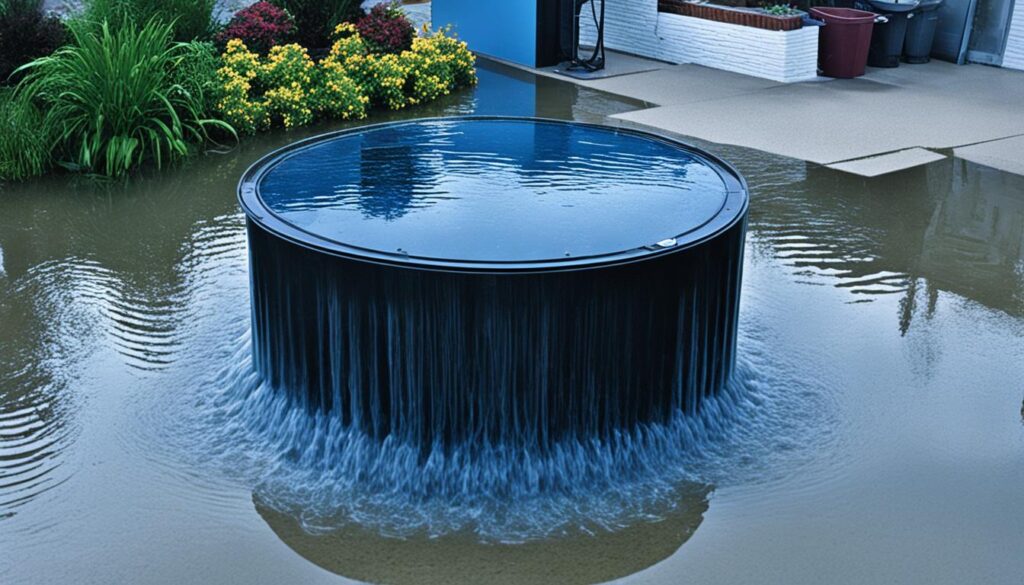
“Acting quickly and having the necessary supplies on hand can make all the difference in saving your tank and its inhabitants from the devastating effects of leaks or floods.”
Remember, prevention is key to avoiding leaks and floods in the first place. Regular tank maintenance, including inspecting seals and fittings, can help identify and address potential issues before they become emergencies. Having a thorough understanding of your tank’s components and investing in quality silicone, plumbing supplies, and leak detection systems is essential for maintaining the integrity of your tank and the safety of your aquatic ecosystem.
Prevent and Treat Disease Outbreaks
Disease outbreaks can be a significant concern in freshwater tanks. These outbreaks can quickly spread and pose a risk to the health and well-being of the fish in your aquarium. It is crucial to take proactive measures to prevent and treat these outbreaks to maintain a healthy aquatic environment.
Quarantine Tank
Having a quarantine tank is a vital component of disease outbreak prevention. A quarantine tank allows you to isolate any new fish or plants before introducing them to your main tank. This helps to prevent the introduction of potential diseases to your existing aquatic population. When introducing new additions, it is essential to observe them for any signs of illness before transferring them to the main tank.
Medications
Having common medications on hand is crucial for treating and managing disease outbreaks. Swift identification and treatment of diseases can help minimize their impact on your aquarium’s inhabitants. Research and stock up on medications that are effective against common diseases such as ich, fin rot, and fungal infections. Follow the instructions provided with the medications carefully to ensure proper dosage and treatment.
UV Sterilizers
UV sterilizers are effective tools for preventing the spread of disease-causing pathogens and parasites in your freshwater tank. These devices utilize ultraviolet light to neutralize or kill microorganisms in the water, reducing the risk of disease outbreaks. Installing a UV sterilizer as part of your filtration system can help maintain a healthier and safer environment for your fish.
| Benefits of Disease Outbreak Prevention Measures |
|---|
| Isolates and treats infected fish |
| Prevents the introduction of diseases |
| Reduces the risk of disease outbreak |
| Maintains a healthier aquatic environment |
By implementing these preventive measures, you can significantly reduce the likelihood of disease outbreaks and minimize the impact they may have on your freshwater tank. Remember to regularly monitor your aquarium for any signs of illness or disease, and take immediate action to address any issues that arise.

Maintain Water Quality
Proper water quality is paramount for ensuring the health and well-being of your fish. By implementing a few simple maintenance practices, you can create a clean and thriving aquatic environment.
Using Activated Carbon
One effective method to remove contaminants from the water is by using activated carbon. This porous substance acts as a powerful adsorbent, trapping impurities and toxins, and enhancing water clarity. Incorporate activated carbon into your filtration system to keep the water clean and safe for your fish.

Regular Water Changes
Regular water changes are essential for diluting and eliminating foreign contaminants. By replacing a portion of the tank water on a consistent basis, you can remove excess nutrients, waste, and other pollutants that may accumulate over time. Aim to perform weekly water changes, replacing about 10-20% of the total volume.
Filter Maintenance
Keeping your aquarium filter clean and properly maintained is crucial for optimal water quality. Follow the manufacturer’s recommendations for filter maintenance, which may include rinsing and replacing filter media, cleaning impellers, and removing debris. A clean and efficient filter ensures effective removal of impurities, keeping your fish healthy.
By employing these practices, you can maintain excellent water quality, providing a healthy and thriving environment for your aquatic companions.
Proper Water Change Procedures
Performing regular water changes is an essential aspect of maintaining a healthy freshwater tank. By replacing a portion of the water, you can remove accumulated toxins and replenish vital nutrients for your aquatic inhabitants.
When conducting a water change, it is crucial to follow proper procedures to ensure the well-being of your fish. Let’s walk through the steps:
Step 1: Gather Your Supplies
Before starting the water change process, gather all the necessary supplies:
- A clean bucket
- A siphon or gravel vacuum
- A water conditioner
- Aquarium-safe scrub brush or pad
Step 2: Prepare the Tap Water
Fill the clean bucket with tap water. Remember, it is essential to treat tap water with a suitable water conditioner before adding it to the tank. Water conditioners neutralize harmful chemicals, such as chlorine or chloramines, that can be detrimental to your fish’s health.
Follow the manufacturer’s instructions on the water conditioner bottle to determine the correct dosage for the amount of water you are changing.
Step 3: Start the Siphon
Using a siphon or gravel vacuum, start the siphoning process by submerging the end of the tube in the tank and allowing it to fill with water. Once the tube is filled, place the other end in the bucket to allow the water to flow out.
While siphoning, gently move the vacuum over the gravel or substrate to remove debris and waste that has settled on the bottom of the tank. Take care not to disturb any beneficial bacteria colonies growing in the substrate.
Step 4: Remove the Desired Amount of Water
Decide on the volume of water you want to change. As a general rule of thumb, changing 10-20% of the total tank volume is recommended for most tanks. Adjust the volume based on the specific needs of your aquarium and the water parameters.
Monitor the flow of water as you remove the desired amount. Be cautious not to siphon out too much water, as this can disrupt the biological balance of the tank.
Step 5: Clean the Tank and Decorations
While the water is draining, seize the opportunity to clean the tank and decorations. Use an aquarium-safe scrub brush or pad to gently remove any algae or dirt buildup on the walls, rocks, and ornaments.
Ensure that the cleaning tools you use are specifically designed for aquarium use to avoid introducing any harmful substances to the tank.
Step 6: Add Conditioned Water
Once the desired amount of water has been removed and the tank is clean, it’s time to add the conditioned tap water to the tank.
Slowly pour the treated water back into the aquarium, taking care not to disturb the fish or the substrate. Gradual addition of water helps to maintain water parameters and prevent stress on your fish.
Step 7: Monitor and Observe
After completing the water change, take a moment to observe your fish and monitor their behavior. Healthy fish should appear active, vibrant, and have a good appetite.
Regular water changes, in combination with proper feeding and maintenance, are key to maintaining a healthy and thriving freshwater tank.
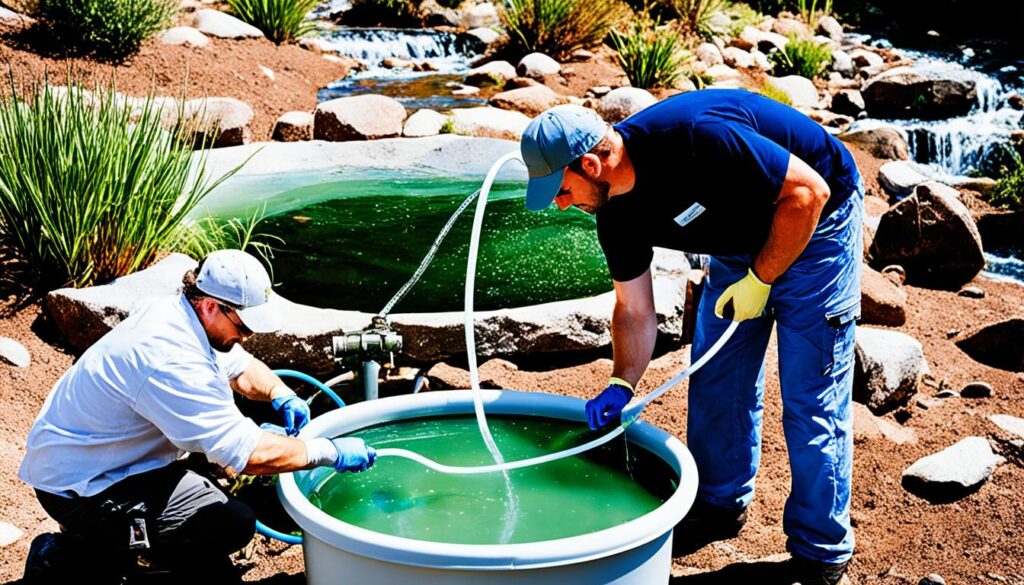
| Water Change Frequency | Recommended Interval |
|---|---|
| Low Bioload Tank | Every 2-4 weeks |
| Moderate Bioload Tank | Every 1-2 weeks |
| High Bioload Tank | Every 1 week |
Troubleshooting the Freshwater Generator
The freshwater generator is a vital machinery system on ships, responsible for producing fresh water from seawater. To ensure its smooth operation and prevent any issues, it is crucial to follow a regular maintenance schedule and take proper precautions during operation.
Here are some common problems that can occur with freshwater generators:
- Low distillate generation rate: This can indicate fouling or scaling in the heat exchanger or issues with the evaporator. Regular cleaning and maintenance of these components can help improve the generation rate.
- Dropping evaporation temperature: If the evaporation temperature drops below optimal levels, it may be due to improper water flow, a malfunctioning control valve, or a defective temperature sensor. Troubleshooting and correcting these issues can restore the temperature to the desired range.
- Vacuum leaks: Vacuum leaks can lead to a decrease in the efficiency of the freshwater generator. Inspecting and repairing any leaks in the condenser, brine heater, or other components is essential to maintain optimal performance.
- Malfunctioning water ejectors: Water ejectors play a crucial role in creating the vacuum necessary for distillation. If there are problems with the water ejectors, such as blockages or worn-out parts, they should be cleaned or replaced to ensure proper functioning.
By addressing these common problems, you can troubleshoot the freshwater generator and maintain its efficiency and performance.
Troubleshooting the Freshwater Generator
| Problem | Possible Causes | Solution |
|---|---|---|
| Low distillate generation rate | Fouling or scaling in the heat exchanger, issues with the evaporator | Regular cleaning and maintenance of heat exchanger and evaporator |
| Dropping evaporation temperature | Improper water flow, malfunctioning control valve, defective temperature sensor | Troubleshooting and correcting water flow issues, repairing or replacing control valve or temperature sensor |
| Vacuum leaks | Leakage in condenser, brine heater, or other components | Inspection and repair of vacuum leaks |
| Malfunctioning water ejectors | Blockages or worn-out parts | Cleaning or replacement of water ejectors |
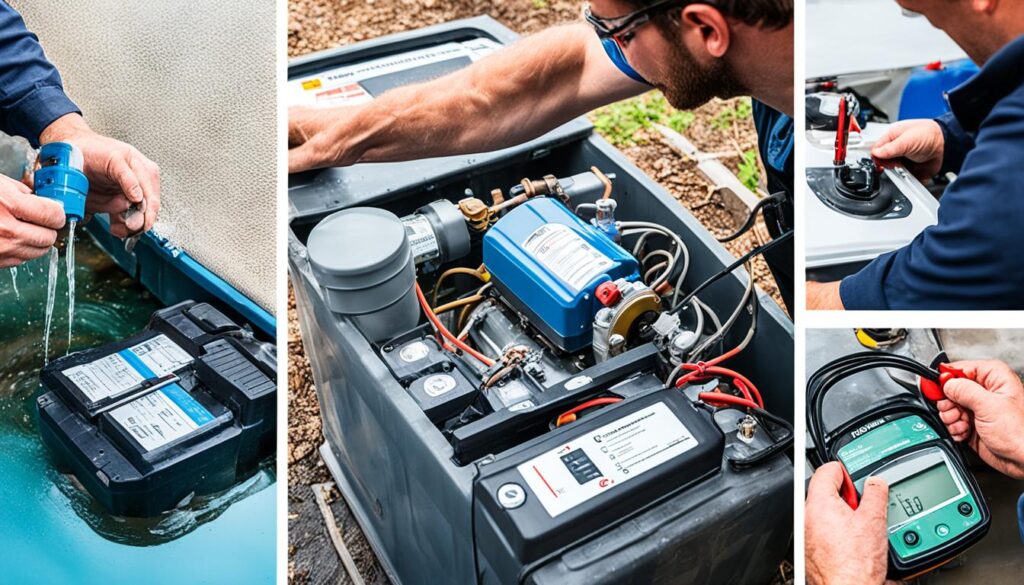
Conclusion
Troubleshooting freshwater tank emergencies is essential for the well-being of your aquatic pets. By addressing common issues such as temperature fluctuations, water flow problems, power outages, leaks, disease outbreaks, and water quality issues, you can effectively handle emergency situations and prevent further damage to your tank.
Regular maintenance is key to preventing emergencies. By monitoring the water temperature and ensuring proper water flow, you can avoid sudden changes that can be harmful to your fish. Having backup equipment like heaters and pumps is crucial in case of failures. Additionally, addressing power loss with generators or battery backup systems can save your tank during outages.
Leaks or floods can be disastrous, but being prepared with silicone, plumbing supplies, and leak detectors can help you quickly fix the issue and minimize damage. Disease outbreaks can spread quickly, so having a quarantine tank and common medications on hand is crucial for isolating and treating infected fish. Good water quality is vital, and using activated carbon, conducting regular water changes, and properly maintaining the aquarium filter can keep your tank healthy.
In conclusion, by taking proactive measures and being prepared, you can effectively troubleshoot freshwater tank emergencies. Remember to conduct regular maintenance, have backups, and use proper equipment. By doing so, you can ensure the safety and well-being of your freshwater tank inhabitants.
FAQ
What are some common reasons for freshwater tank emergencies?
Common reasons for emergencies include water temperature fluctuations, water flow problems, power loss, leaks or floods, disease outbreaks, and water quality issues.
How can I prevent temperature fluctuations in my freshwater tank?
To prevent temperature fluctuations, monitor the water temperature using a thermometer or aquarium controller and have a backup heater on hand. Using two heaters and replacing them annually can also help maintain a stable temperature.
What should I do if the water flow in my tank is not working properly?
If the water flow is not working properly, have a backup return pump and a battery-powered air pump on hand to maintain water movement and oxygenation during a power outage. Consider using a battery backup system or generator to keep the water flowing during longer power outages.
How can I address power loss in my freshwater tank?
To address power loss, have a generator or battery backup system to keep your tank running. Choose the right generator based on your tank’s power needs and regularly test the battery backup system to ensure it is functioning properly.
What should I do in case of leaks or floods in my tank?
In case of leaks or floods, have the necessary supplies such as silicone, Teflon tape, and plumbing parts on hand. Use leak detectors and water alarms for early warning. Have a holding bin or spare tank to temporarily house the fish if the main tank becomes damaged.
How can I prevent and treat disease outbreaks in my freshwater tank?
To prevent and treat disease outbreaks, have a quarantine tank and common medications on hand. Consider using UV sterilizers to reduce the presence of disease-causing pathogens and parasites in the tank.
How can I maintain good water quality in my freshwater tank?
Maintain good water quality by using activated carbon to remove contaminants and regularly performing water changes to dilute and remove foreign contaminants. Clean and maintain the aquarium filter to ensure proper functioning and prevent water quality issues.
What is the proper procedure for water changes in my freshwater tank?
When performing water changes, treat the tap water with a water conditioner before adding it to the tank. Clean the tank, decorations, and glass to remove debris or algae buildup.
How can I troubleshoot issues with my freshwater generator?
Follow the maintenance schedule and take proper precautions while operating the freshwater generator. Address common problems such as low distillate generation rate, dropping evaporation temperature, vacuum leaks, and malfunctioning water ejectors by cleaning, repairing, or replacing specific components.
How do I effectively handle freshwater tank emergencies?
To effectively handle emergencies, be prepared with backups and necessary supplies, monitor the tank’s conditions, and take prompt action to address any issues that arise. Regular maintenance and the use of appropriate equipment are essential for preventing and resolving emergencies.

